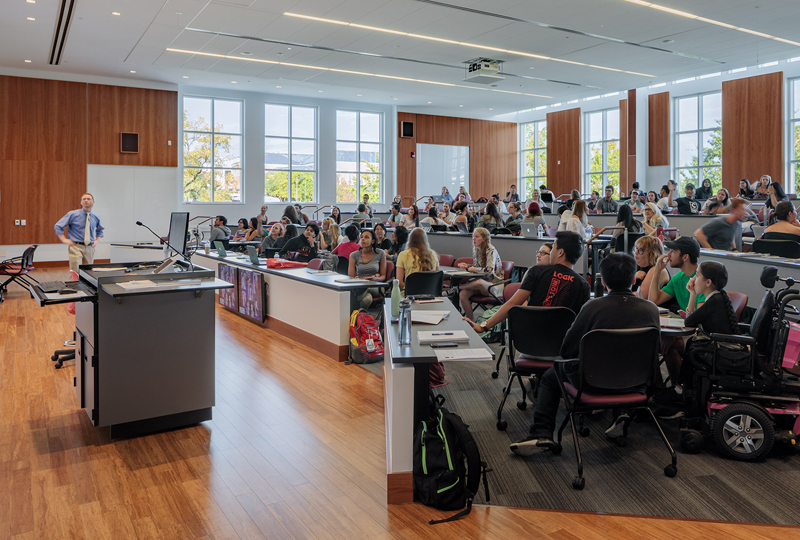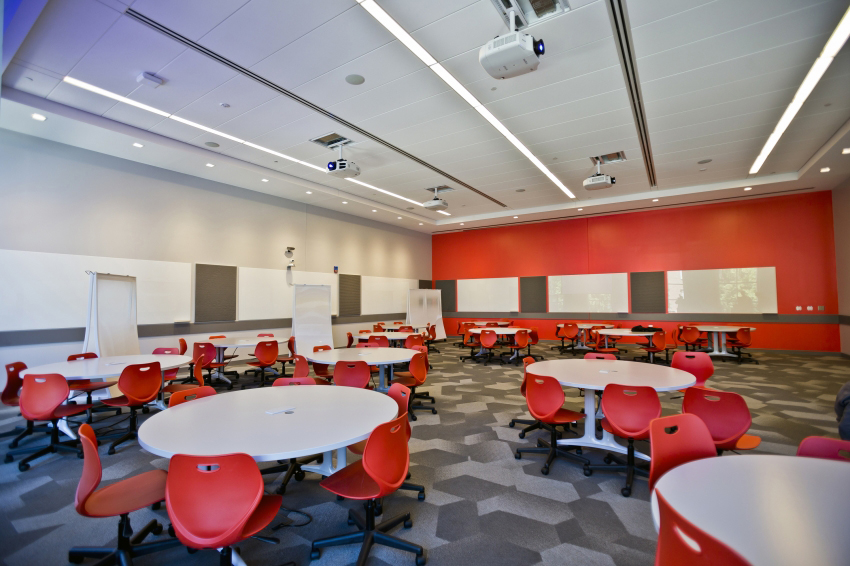The Baltimore Sun | Gregory J. Alexander, Contributing writer
New frontiers in education New high-tech facilities change the face of learning
Long gone are the days where a professor stands at a lectern at the front of the class, while students feverishly take handwritten notes. Nowhere is this more evident than the new Edward St. John Learning and Teaching Center at the University of Maryland. The 187,000-square-foot space, which includes 12 classrooms and nine teaching labs with a total of 1,500 seats, is a stunning building focused on a student-centered approach to learning and teaching. The new building also enables more “active learning.”
“You cannot expect someone to learn how to play the violin by only watching someone else play nor can you learn how to play tennis by only watching a tennis match. Likewise, evidence shows that only listening to lectures is not the best way to learn … students must use their own muscles,” says Ben Benderson, Ph.D., associate provost of learning initiatives and executive director of the Teaching and Learning Transformation Center at the University of Maryland.
One of the key elements that promotes active learning are TERP (Teach, Engage, Respond and Participate) classrooms with flexibility such as tiered seating, mobile desks and swiveling chairs that encourage active learning and collaboration. “All seats enable movement, which allows for students to interact with each other and collaborate. Also, the instructor can join small groups of students, observe and guide the discussion. You cannot do this in a stadium-style classroom,” Benderson says.
Benderson adds that peer mentors also can easily interact with students. Especially useful for large classes, Academic Mentor (AMP) students are ones who recently took the course and they assist the instructor by working with students currently taking the course. “Even if they were not an A student and perhaps even struggled when they took the course, they can share their experience of how they persevered,” he says.
Classrooms and labs at the Edward St. John Learning and Teaching Center are extremely high-tech, although Benderson stresses that technology is not the driver, pedagogy is. The classrooms feature technology that encourages wireless screen sharing, making it possible for students to collaborate with their peers in classes of all sizes. “High-resolution, large, bright screens are visible to every seat, and in the round classrooms, multiple screens are positioned so that every student can view them easily,” he says. Power stations allow students to charge their devices (especially if they have three or four classes in succession), and strategically placed microphones (either in the ceiling or in working tables) allow students to share their thoughts with the entire class.
Taking STEM to a Whole New Level
The moment you walk into the brand new 145,300-square-foot Science, Engineering, and Technology (SET) Building at Howard Community College, your eyes are drawn to the three-story glass wall that celebrates the men and women across STEM disciplines who made an impact on the field and the world. “The architect actually charged the faculty and students involved in this project to design the glass wall. We wanted to unify the various disciplines and include the names of individuals who are admired in STEM,” says Patti Turner, dean of science, engineering and technology at Howard Community College, who admits the task of designing this massive feature was daunting.
Turner says the current science building was built in 1987 and only had 14 labs for the largest division on campus. “We had to have labs on Saturdays and Sundays to accommodate all the classes … we obviously had outgrown the space,” she says. The new SET building will double the lab space, and each lab space will have large prep rooms, all uniquely designed to fit the needs of a particular class. For example, chemistry faculty can use cameras that project up-close experiments into adjoining classrooms, engineering students can fly drones in an outdoor yard, and students can use the physics drop zone to measure velocity. Plant science students can work in a large greenhouse, while astronomy students can utilize the observation deck on the roof.
Classrooms are also breaking the mold. “Rooms can be set up any way imagined and then quickly adapted, as everything is foldable and collapsible,” Turner says. Flat-screen monitors allow for students to share information with each other wirelessly, and a dedicated undergraduate research area allows even freshman students to engage in cutting-edge research.
Seeing the World Without Leaving Campus
Having a worldview is emphasized on many college campuses – encouraging students to look beyond the U.S. borders and explore different cultures and viewpoints. At Notre Dame of Maryland University, faculty members are utilizing technology to expose students to the world. In a global digital classroom, interactive video technology and large screens allow students to interact with individuals anywhere in the world.
“For a class discussion on terrorism, we can connect with a professor who’s teaching a terrorism class in France or the Middle East,” says Anne Henderson, Ph.D., associate professor and chair of the department of history and political science at Notre Dame of Maryland University. “A lot of our students work or don’t come from privileged backgrounds, so study abroad may not be feasible for them. We want to educate leaders to transform the world, so this helps us honor this mission.”
Henderson says that the interactive capabilities of the global digital classroom provide experiences that cannot be found in a text or lecture. “My work focuses on conflict and genocide, and I lived and worked in Rwanda. I have a mental picture in my mind of Rwanda because I was there. So, if I can Skype in a genocide survivor in Rwanda, it becomes so much more real for my students,” she says.
The global digital classroom is also used to allow students to interact with work being done at the United Nations. As the first university in Maryland to be granted nongovernmental organization status by the United Nations’ Department of Public Information, NDMU is able to take students to the U.N.; however, for those not able to go to New York, they can still experience it through video streaming.
Henderson says that the technology also encourages study abroad. “One of my students did study abroad in Jordan and when she returned so showed a multimedia presentation on her experience. I had students say that they had never considered studying abroad in the Middle East, but seeing a fellow classmate’s videos really opened their eyes,” Henderson says. “It also helps promote service learning. We had science students go to Pakistan to help build trust with different tribes on the safety of vaccines. When a student watches a video of a mother cradling her child receiving vaccines, it’s very impactful.”?
Amazing opportunity
To say that Kathleen Hamilton is excited about the new Science, Engineering, and Technology (SET) Building at Howard Community College would be a massive understatement. Hamilton, who will complete her associate degree from HCC this fall and aims to transfer to the University of Maryland to study astronomy, will have three classes in the new building this fall, and she recognizes how fortunate she is that she can utilize the new high-tech labs found there.
“The lab rooms are state of the art, and every floor has specific areas for collaboration with fellow students and faculty,” Hamilton says. “Also, there are designated areas with white boards where we can meet professors and practice presentations instead of practicing in the hallways.”
She can also continue her research at SET. Hamilton, who has conducted research on dark matter and the dynamics of the double pendulum and the mathematical principles of chaos, says she hopes to further her research on these and other research projects at SET. “I’m also really excited about the observation deck on the roof where we can have star watching parties,” she says.


